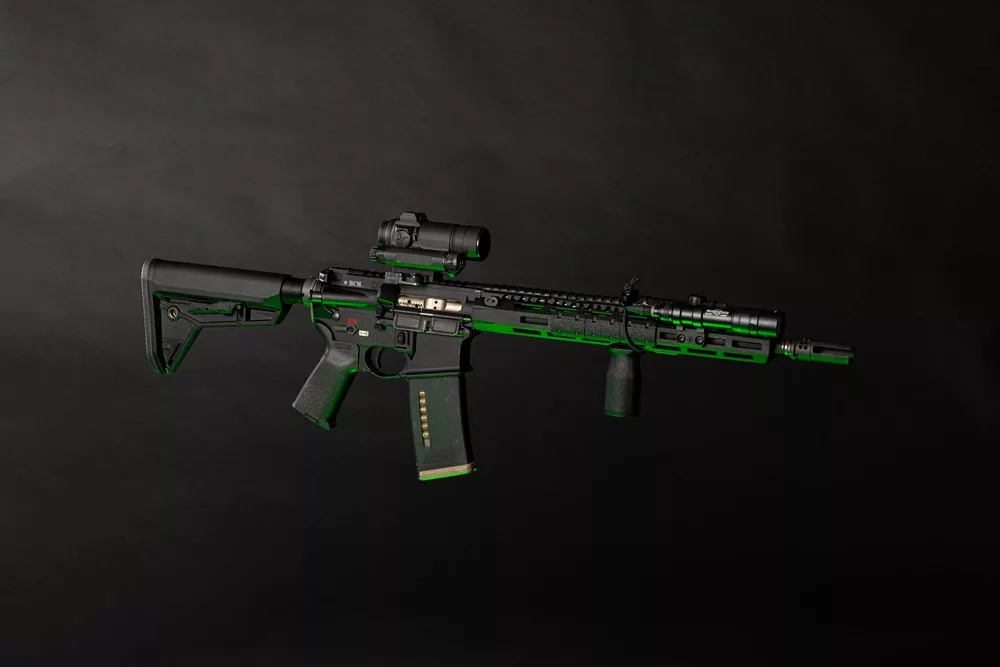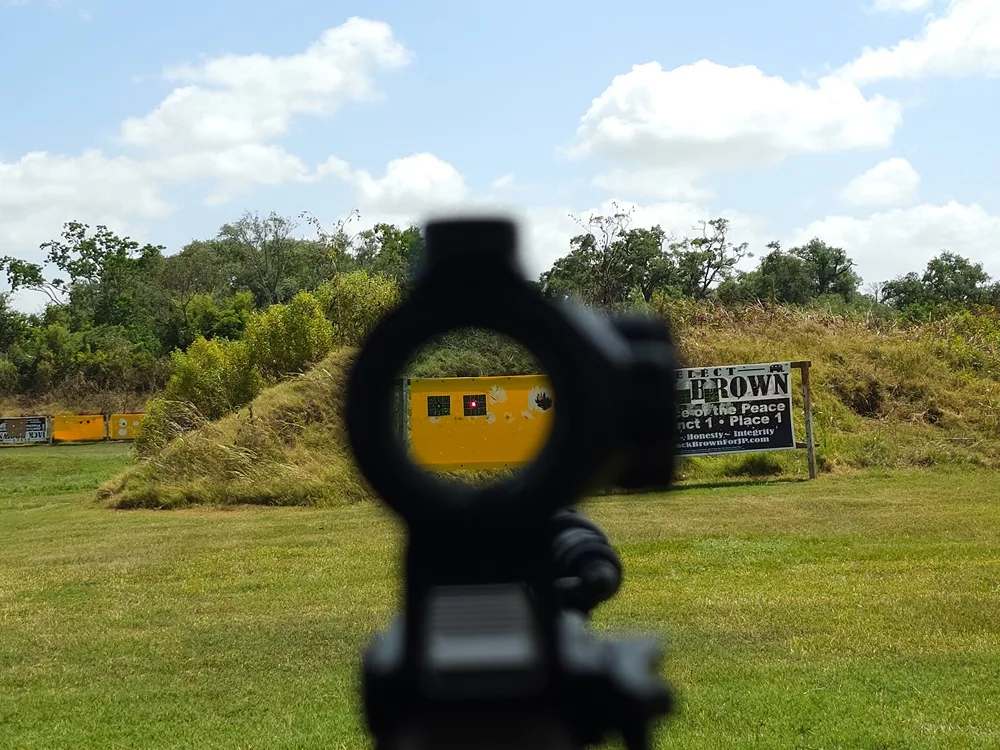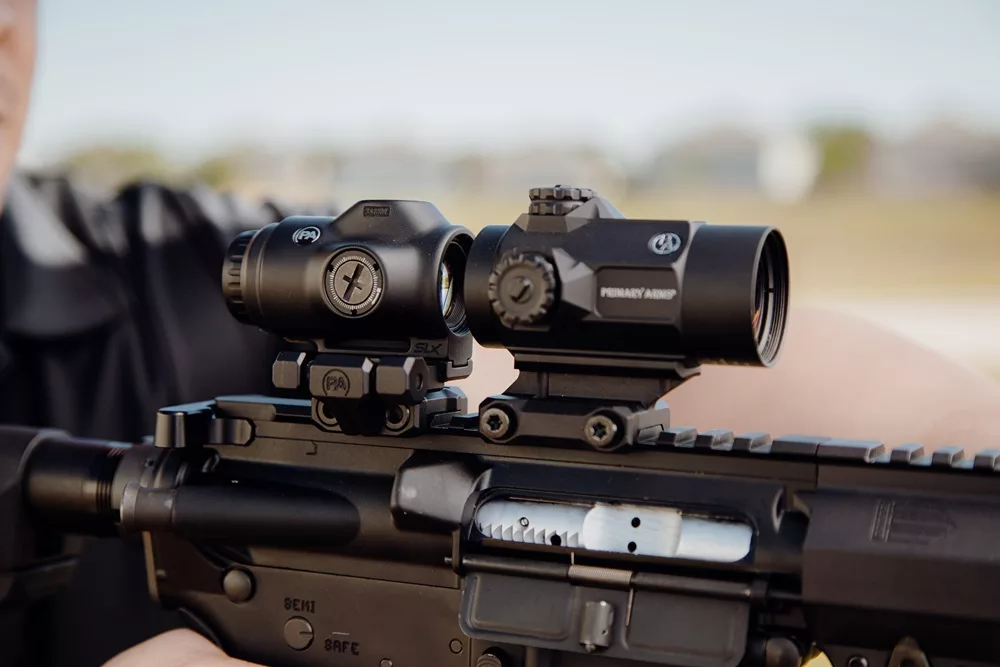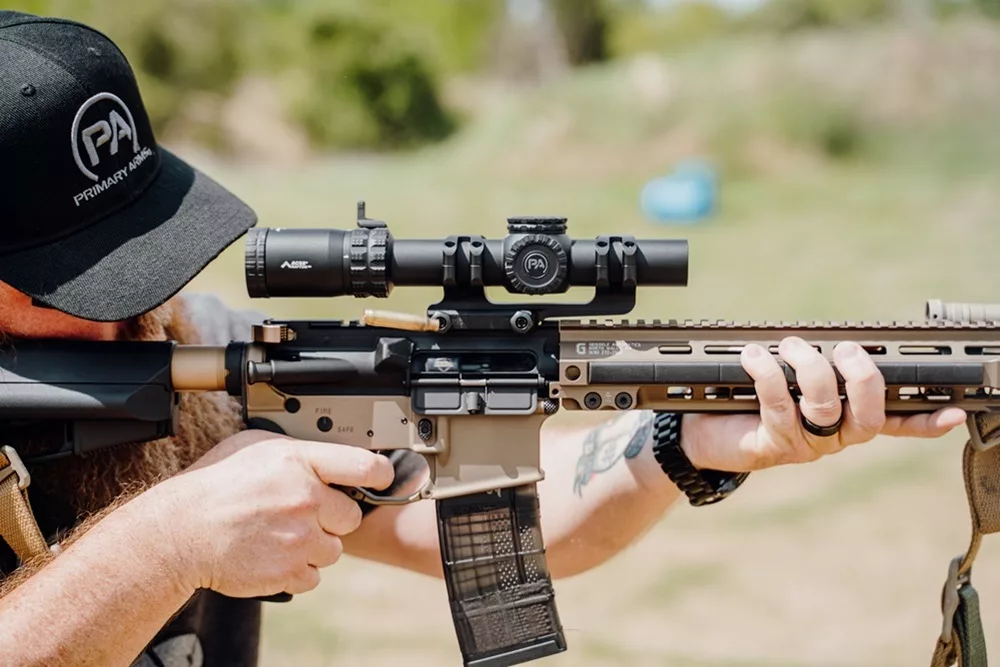It’s understood that red dot sights are among the most popular sight options for rifles like the AR-15. Their infinite eye relief and wide field of view make them exceptionally agile optics and ideal for applications requiring fast target acquisition. But what about shooting at distance?
Reflex sights aren’t typically the go-to optic for long-range shooting. That said, these optics can still feature complex reticles and be paired with magnifiers to extend their range. So that begs the question, what is the true effective range of a red dot sight?

Understanding Red Dot Sights
Before diving into the effective range of red dots, it’s important to know how they work. Simply put, these optics project a reticle from an emitter diode built into the optic. The light emitted from the diode is collimated onto the objective lens of the sight, creating a reticle image.
Many enthusiasts mistakenly believe that red dot and reflex sights are synonymous, but this isn’t true. The term “reflex sight” is actually a broader category of optics, with red dot sights existing as a subcategory of them. The core difference between different reflex sights is their construction.
Traditional open-emitter reflex sights only have one lens, and as their name suggests, feature an open-emitter design, whereas red dot sights are fully enclosed and have two lenses. Holographic sights are another category of reflex sight and differ slightly from red dots. Instead of bouncing light off a single point, they bounce it off several to create a hologram reticle between the two lenses.
Despite their differences in construction, all three reflex sight options achieve the same goal, but they have their own distinct pros and cons. To get a better idea of how they stack up against each other, our guide on how red dot sights work will round out your knowledge on each possibility.
Advantages of Red Dot Sights
Compared to other optic options, red dots offer a lot of benefits. First, they can be incredibly lightweight and compact, freeing up some of the rail space on top of your AR-15 for other accessories or optics like backup iron sights or a magnifier, for example.
One of their key advantages is their improved target acquisition abilities. For example, iron sights require you to line up both the front and rear sight to get on target, and then you need to keep your focus on the front sight rather than the target itself. With red dots sights, all you must do is put the reticle on target, making them ideal for scenarios where speed and agility are paramount. While this is true of open-emitter reflex sights too, red dot sights have the distinct advantage of being an enclosed optic. No dirt or debris can get into the optic, always protecting the diode. Plus, they usually have longer battery lives than holographic sights, too.
They also greatly improve the user’s situational awareness. It’s generally recommended to shoot with both eyes open regardless of what optic you’re using, but it’s particularly easy to do so with a red dot. Your dominant eye will pick up the reticle, while your other one picks up everything else. Both images combine to give you a wide and detailed sight picture, allowing you to place your full focus on the target without compromising any of your peripheral vision in the process.
Red Dot Disadvantages
Although red dot sights have many benefits, they aren’t perfect, and they come with limitations that need to be considered as well.
Being an electronic optic, they require batteries to work, which can fail at inopportune times. Fortunately, modern red dot sights have battery lives that can last upwards of 50,000 hours, d. Remember, a long battery life depends heavily on the brightness settings you use when shooting, as well as how often you shoot your rifle and optic, so individual battery lives can vary.
Another potential issue is astigmatism. If you have astigmatism, the reticle of your optic may appear to be distorted instead of being a crisp circular dot. Keep in mind that it’s still more than possible to use a red dot if you suffer from astigmatism, but you may need to opt for one that has either a larger dot diameter like a 3- or 6-MOA dot, or a different reticle entirely.

Effective Range and Performance of Red Dot Sights
By design, red dots are optimized for close range applications, but that doesn’t mean they can’t be effective at longer distances.
As we mentioned before, the most common reticle choice on red dot sights is the standard dot. Simple and effective, this reticle is available in multiple sizes, ranging from 2-3 MOA up to 6 MOA. If you don’t already know what MOA is, it stands for “minute of angle” and refers to either the measurement used for adjusting/zeroing your optic, or the size of the reticle itself. In terms of reticle size, a smaller MOA results in a finer reticle. 1 MOA approximates a 1-inch diameter at 100 yards, meaning a standard 2-MOA reticle would cover roughly 2 inches of the target at 100 yards, and even more so if you had a larger reticle
For standard use, this is perfectly fine, however, once your targets begin to exceed around 150 to 200 yards, the reticle is going to start covering up more of the target and eventually get to where your point of impact won’t even be within the dot, making it harder to maintain accuracy. BDC reticles can help with this though, as they provide added targeting information to better allow you to lead your target and hold for bullet drop.
AR-15 Effective Range
To understand the limitations of red dots at longer distances, it’s important to consider the effective range of your AR-15. Most AR-15s are chambered in 5.56 NATO, which when fired out of a 16-inch barrel, has an effective range of roughly 500 yards. Specialty 5.56 loads, like Mk. 262, can push this range out to around 750+ yards. Other AR-15 calibers like 6.5 Grendel, 6mm ARC, and .224 Valkyrie are known for their long-range accuracy, with both being capable of landing shots on targets up to 1000+ yards away.
Even the best optics can only enhance a rifle’s inherent accuracy. Rifles built with lower quality parts aren’t going to be accurate as something that’s purpose built for marksmanship. If you’re wanting a well-rounded AR-15, we recommend opting for one built by top-tier brands like Geissele, LaRue Tactical, or Daniel Defense. You can also build one with quality parts as well to ensure it has consistent performance at long range.
Factors Affecting Accuracy and Precision
Accuracy and precision are often used interchangeably, but they’re two distinct concepts. Accuracy refers to how close your shots land to the intended point of impact, while precision refers specifically to how consistent your shot placement is.
For example, if your shot grouping is very close together but off-target, it would be precise but not accurate. If your impacts are scattered but hit your desired point of impact, it’d be accurate but not precise. Being both accurate and precise is the ideal combination for marksmanship.
Red dot sights can be very accurate and precise within their usable distance. As we mentioned before, as your target distance increases, the reticle will start obscuring more of the target. If your optic is zeroed, you’ll be able to maintain accuracy at longer distances past around 300 yards, but they won’t necessarily be extremely precise.
A reticle with BDC (bullet drop compensation), like the Primary Arms ACSS® CQB Reticle, will give you the best long-range capabilities. It has three added dots, allowing you to compensate for bullet drops on targets up to 600 yards away. Plus, it comes with an infinitely precise center chevron, so it will never cover up the target, at least until your POI is below the chevron tip. Still, bear in mind that a red dot sight is not designed for dedicated long-distance shooting.
Magnifiers and Other Optics

Magnifiers: On their own, red dots are limited in their long-range capabilities, but a red dot magnifier can add some reach to your rifle. A magnifier is a separate optic that sits behind the red dot, magnifying its sight picture for better target identification and acquisition at distance. Magnifiers typically anywhere from 3x to 6x magnification, and they usually come with flip mounts as well so you can easily switch between magnified and non-magnified use.
Although they can certainly help with long range shooting, magnifiers are still limited by the reticle size of the red dot. When you magnify a red dot, you’ll be able to see just how much of the target is covered by the reticle, and once your POI is below the dot, you still won’t have an effective point of aim unless your sight has a BDC reticle.

LPVOs: Low power variable optics are an increasingly popular optic option for the AR-15. LPVOs often feature either a 1-6x, 1-8x, or 1-10x magnification range, which covers a wide range of distances. Unlike red dots, LPVOs utilize etched reticles, which are much finer and capable of having multiple complex elements for windage holds and bullet drop compensation. Also, while a magnifier only has one setting, you can freely adjust the magnification on an LPVO to fit the scenario.
At 1x magnification, they can function similarly to red dots but aren’t as quick since they don’t have as forgiving an eye box. If you’re on the fence about which to go with, our guide on LPVOs vs. red dots with magnifiers goes more in-depth on the specifics of each one.
Conclusion
Red dot sights certainly excel in close-to-mid-range applications, offering both quick target acquisition speed and better situational awareness, making them some of the most popular AR-15 optics available. Despite their inherent utility, their limitations become increasingly more apparent the farther you are away from your target.
Although magnifiers and specialized red dot reticle systems can make distance shooting easier, they simply can’t match the effectiveness of specialized long-range optics. Still, the versatility of red dot sights shouldn’t be underestimated. For most practical carbine shooting distances, they’re more than usable, plus, when used with a magnifier, you can quickly switch between close and medium range shooting. That said, if you know you’re going to be engaging targets beyond 500 yards, we recommend going with something like an LPVO or another kind of variable power optic.
Understanding the strengths and limitations of your optic is crucial to having a cohesive and functional AR build. If you decide to get a reflex sight for your AR build, our guide on how to sight in a red dot will set you up for success.





